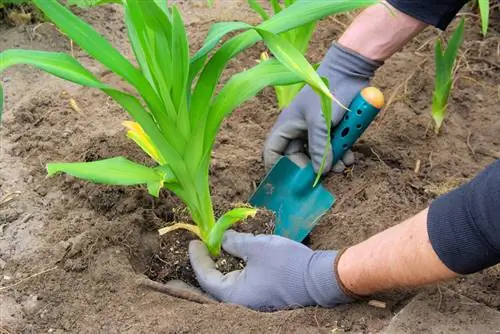- Author admin [email protected].
- Public 2024-01-05 20:48.
- Last modified 2025-01-23 11:21.
The enormous growth of a weeping willow is often underestimated. While the tree was an attractive eye-catcher just a few months ago, six months later it can become a nuisance in your own garden. If the weeping willow does not grow as expected, it may also be due to an unfavorable location. In both cases you should then transplant the deciduous tree. On this page you will find out up to what age this is possible and how best to proceed.

How should you transplant a weeping willow?
To successfully transplant a weeping willow, choose a frost-free day in the fall, dig a sufficiently large hole and plant the tree without damaging many roots. Then cut back heavily and water well.
Time
It is best to transplant a weeping willow outside of the growth phase. A frost-free day in autumn is ideal. If, on the other hand, the tree is in the process of budding, the change of location would be a great drain on its strength. However, the age of your weeping willow and the resulting size are much more important than the season. Older specimens can no longer be moved due to their massive root growth.
Reasons for transplanting
- heavy leaf shedding
- Neighbor's complaint
- Danger from falling branches
- too dry soil
- too little light
- Weeping willow takes away the light from other plants
- Roots lift stones or sidewalks
Instructions
- Dig a sufficiently large hole at the new location.
- Add compost to the soil.
- Expose the root ball.
- Be careful to damage as few roots as possible.
- You still have to cut through some rhizomes with a spade (€29.00 on Amazon).
- Lift the weeping willow from the ground.
- Place the tree in the hole you dug.
- Fill the remaining hole with soil.
- Water the weeping willow well.
Promote new shoots
It is completely normal for your weeping willow to weaken a little after being transplanted. If you have chosen a suitable location and only separated a few roots, it will soon recover. In order to promote sprouting, it makes sense to cut the weeping willow back significantly. This means that the roots have to support less above-ground growth.






